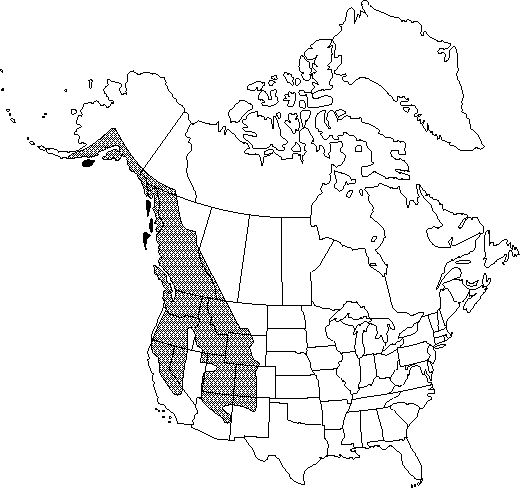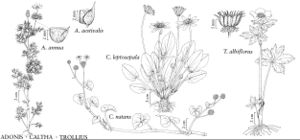Difference between revisions of "Caltha leptosepala"
Syst. Nat. 1: 310. 1817.
FNA>Volume Importer |
imported>Volume Importer |
||
| (6 intermediate revisions by 2 users not shown) | |||
| Line 12: | Line 12: | ||
}}{{Treatment/ID/Special_status | }}{{Treatment/ID/Special_status | ||
|code=F | |code=F | ||
| − | |label= | + | |label=Illustrated |
}} | }} | ||
|basionyms= | |basionyms= | ||
| Line 18: | Line 18: | ||
|name=Caltha biflora | |name=Caltha biflora | ||
|authority=de Candolle | |authority=de Candolle | ||
| − | }}{{Treatment/ID/Synonym | + | |rank=species |
| + | }} {{Treatment/ID/Synonym | ||
|name=Caltha biflora subsp. howellii | |name=Caltha biflora subsp. howellii | ||
|authority=(Huth) Abrams | |authority=(Huth) Abrams | ||
| − | }}{{Treatment/ID/Synonym | + | |rank=subspecies |
| + | }} {{Treatment/ID/Synonym | ||
|name=Caltha biflora var. rotundifolia | |name=Caltha biflora var. rotundifolia | ||
|authority=(Huth) C. L. Hitchcock | |authority=(Huth) C. L. Hitchcock | ||
| − | }}{{Treatment/ID/Synonym | + | |rank=variety |
| + | }} {{Treatment/ID/Synonym | ||
|name=Caltha howellii | |name=Caltha howellii | ||
|authority=(de Candolle) W. Weber | |authority=(de Candolle) W. Weber | ||
| − | }}{{Treatment/ID/Synonym | + | |rank=species |
| + | }} {{Treatment/ID/Synonym | ||
|name=Caltha leptosepala var. rotundifolia | |name=Caltha leptosepala var. rotundifolia | ||
|authority=Huth | |authority=Huth | ||
| − | }}{{Treatment/ID/Synonym | + | |rank=variety |
| + | }} {{Treatment/ID/Synonym | ||
|name=Caltha leptosepala var. sulfurea | |name=Caltha leptosepala var. sulfurea | ||
|authority=C. L. Hitchcock | |authority=C. L. Hitchcock | ||
| − | }}{{Treatment/ID/Synonym | + | |rank=variety |
| + | }} {{Treatment/ID/Synonym | ||
|name=Caltha uniflora | |name=Caltha uniflora | ||
| − | |authority= | + | |authority= |
| − | }}{{Treatment/ID/Synonym | + | |rank=species |
| + | }} {{Treatment/ID/Synonym | ||
|name=Psychropila leptosepala | |name=Psychropila leptosepala | ||
| − | |authority= | + | |authority= |
| + | |rank=species | ||
}} | }} | ||
|hierarchy=Ranunculaceae;Caltha;Caltha leptosepala | |hierarchy=Ranunculaceae;Caltha;Caltha leptosepala | ||
| Line 54: | Line 62: | ||
|elevation=750-3900 m | |elevation=750-3900 m | ||
|distribution=Alta.;B.C.;Yukon;Alaska;Ariz.;Calif.;Colo.;Idaho;Mont.;Nev.;N.Mex.;Oreg.;Utah;Wash.;Wyo. | |distribution=Alta.;B.C.;Yukon;Alaska;Ariz.;Calif.;Colo.;Idaho;Mont.;Nev.;N.Mex.;Oreg.;Utah;Wash.;Wyo. | ||
| − | |discussion=<p>Caltha leptosepala is morphologically complex, and a number of segregate taxa have been described. Plants are most commonly assigned to two species, however. Caltha leptosepala in strict sense is found in the Rocky Mountains of Arizona and New Mexico north to Alaska and is characterized by longer-than-broad leaves with small, nonoverlapping basal lobes, solitary-flowered inflorescences, and sessile follicles. Plants in the Coast Ranges of central California north to the coastal islands of southern Alaska, distinguished by broader-than-long leaves with large, overlapping basal lobes, 2-flowered inflorescences, and stipitate follicles, have been called C.biflora. My comparison of specimens from the Rocky Mountains and the Coast Ranges indicated that no clear distinction could be made (table 1). While plants are often distinctive in the southern part of their range, a continuous intergradation between the two extremes exists over much of their range.</p> | + | |discussion=<p><i>Caltha leptosepala</i> is morphologically complex, and a number of segregate taxa have been described. Plants are most commonly assigned to two species, however. <i>Caltha leptosepala</i> in strict sense is found in the Rocky Mountains of Arizona and New Mexico north to Alaska and is characterized by longer-than-broad leaves with small, nonoverlapping basal lobes, solitary-flowered inflorescences, and sessile follicles. Plants in the Coast Ranges of central California north to the coastal islands of southern Alaska, distinguished by broader-than-long leaves with large, overlapping basal lobes, 2-flowered inflorescences, and stipitate follicles, have been called C.biflora. My comparison of specimens from the Rocky Mountains and the Coast Ranges indicated that no clear distinction could be made (table 1). While plants are often distinctive in the southern part of their range, a continuous intergradation between the two extremes exists over much of their range.</p> |
|tables={{Caltha leptosepala Table 1}} | |tables={{Caltha leptosepala Table 1}} | ||
|references={{Treatment/Reference | |references={{Treatment/Reference | ||
| Line 69: | Line 77: | ||
-->{{#Taxon: | -->{{#Taxon: | ||
name=Caltha leptosepala | name=Caltha leptosepala | ||
| − | |||
|authority=de Candolle | |authority=de Candolle | ||
|rank=species | |rank=species | ||
| Line 83: | Line 90: | ||
|publication title=Syst. Nat. | |publication title=Syst. Nat. | ||
|publication year=1817 | |publication year=1817 | ||
| − | |special status=Endemic; | + | |special status=Endemic;Illustrated |
| − | |source xml=https:// | + | |source xml=https://bitbucket.org/aafc-mbb/fna-data-curation/src/2e0870ddd59836b60bcf96646a41e87ea5a5943a/coarse_grained_fna_xml/V3/V3_893.xml |
|genus=Caltha | |genus=Caltha | ||
|species=Caltha leptosepala | |species=Caltha leptosepala | ||
Latest revision as of 21:52, 5 November 2020
Stems leafless or with 1 leaf, erect. Basal leaves: blade oblong-ovate to orbiculate-reniform, largest 1.5-11.5(-15) × 1-13cm, margins entire or crenate to dentate. Inflorescences 1-2(-4)-flowered. Flowers 15-40 mm diam.; sepals white to yellow (abaxially bluish), 8.5-23 mm. Follicles 4-15, spreading, short-stipitate or sessile, linear-oblong; bodies 10-20 × 3-4.5 mm; style and stigma straight or curved, 0.5-1.8 mm. Seeds elliptic, 1.9-2.5 mm. 2n=48,96.
Phenology: Flowering late spring–summer (Jun–Aug).
Habitat: Open, wet, subalpine and alpine marshes, wet seepages
Elevation: 750-3900 m
Distribution

Alta., B.C., Yukon, Alaska, Ariz., Calif., Colo., Idaho, Mont., Nev., N.Mex., Oreg., Utah, Wash., Wyo.
Discussion
Caltha leptosepala is morphologically complex, and a number of segregate taxa have been described. Plants are most commonly assigned to two species, however. Caltha leptosepala in strict sense is found in the Rocky Mountains of Arizona and New Mexico north to Alaska and is characterized by longer-than-broad leaves with small, nonoverlapping basal lobes, solitary-flowered inflorescences, and sessile follicles. Plants in the Coast Ranges of central California north to the coastal islands of southern Alaska, distinguished by broader-than-long leaves with large, overlapping basal lobes, 2-flowered inflorescences, and stipitate follicles, have been called C.biflora. My comparison of specimens from the Rocky Mountains and the Coast Ranges indicated that no clear distinction could be made (table 1). While plants are often distinctive in the southern part of their range, a continuous intergradation between the two extremes exists over much of their range.
Tables
Table 1. Morphologic comparison of Caltha leptosepala from the Rocky Mountains and Coast Ranges.
| Rocky Mountains* C. leptosepala in strict sense | Coast Ranges** C. bicolor in strict sense | |
|---|---|---|
| Leaf (L:W ratio) | 0.8-2.2(-3.1) | 0.4-1.5 |
| Flower number | 2-4 | 1-4 |
| Stipe (mm) | 0-3.2 | 0-2.7 |
*Including Alaska, Arizona, Colorado, Idaho, and Montana.
**Including British Columbia, California, Oregon, and Washington.
